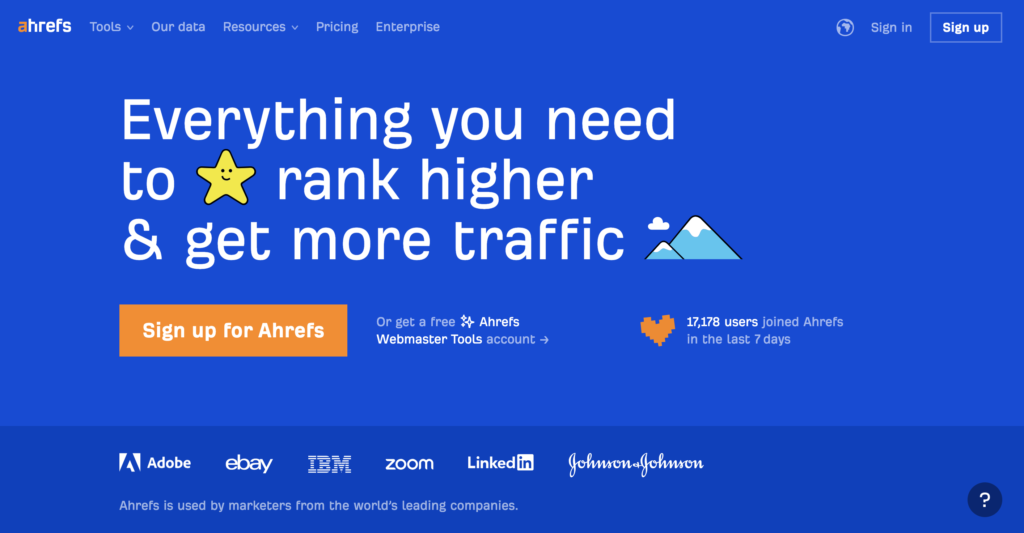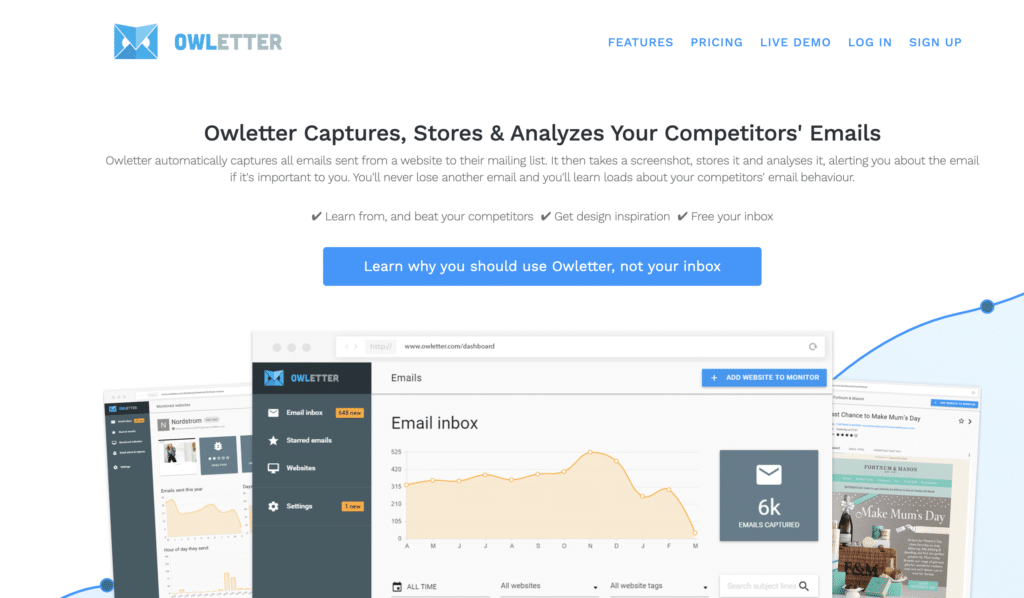Let me make a confession – I don’t know the number of online tools I am currently using – there’s a loooot! 🫣I find my martech stack super useful, but my favorite tools are those that help me to get some ideas, insights, that I just couldn’t think of myself.
That’s why I very often turn into an online super-spy and learn so many things that others are doing that I could benefit from. Here’s where I use my little helpers – a bunch of great online tools that can help you monitor (…which is just a nice word for “spy”) your competition.
In this post I’ll share the best tools to spy on competition, ones I genuinely recommend.
Why Analyzing Your Competitors Matters
Before I introduce you to my fav competitor analysis tools, let’s quickly revisit why this process is so essential for your business:
1. Insight into Their Strategies
Analyzing your competitors allows you to gain valuable insights into their marketing strategies, product offerings, and customer engagement tactics. This information can help you identify what’s working for them and adapt similar approaches to your advantage.
2. Identifying Opportunities
By studying your competitors, you can uncover untapped market opportunities and niche areas that they might have overlooked. This can be a game-changer when it comes to expanding your product or service offerings.
3. Stay Ahead of Trends
Keeping an eye on your competitors enables you to stay up-to-date with industry trends. This knowledge is invaluable for adapting your business strategies and offerings to meet evolving customer demands.
Now that we’ve established the importance of competitor analysis, let’s explore some of the best tools and strategies to help you achieve this.
Disclaimer: I will recommend more sources and tools, but they are not sponsored, or affiliated, just my personal recommendation.
The TL; DR
Tools to spy on your competition (the best ones):
1. SEMrush
2. Ahrefs
3. SimilarWeb
4. BuzzSumo
5. SpyFu
6. Social Blade
7. Google Alerts
8. Owletter
9. BuiltWith
10. Crayon
11. Kompyte
12. Adthena
13. Crayon’s Battlecards
14. Brandwatch
15. Facebook Ads Library
16. Google Transparency Center
Let’s take a closer look and explore each one of these super-useful tools.

1. SEMrush: Your All-in-One Competitor Analysis Solution
SEMrush is a versatile tool that offers a wide range of features to help you spy on your competitors effectively. With SEMrush, you can:
- Analyze your competitors’ websites to discover their top-performing keywords.
- Track their backlinks and identify potential link-building opportunities.
- Gain insights into their paid advertising campaigns, including ad copies and keywords.
- Monitor their social media engagement and audience growth.
- Analyze their content marketing strategies.
SEMrush’s comprehensive toolkit provides valuable data to help you refine your own marketing and SEO strategies.

2. Ahrefs: Uncover Backlink Secrets
Backlinks are a crucial element of any successful SEO strategy, and Ahrefs is the go-to tool for analyzing your competitors’ backlink profiles. With Ahrefs, you can:
- Discover the websites linking to your competitors.
- Evaluate the authority and quality of these backlinks.
- Identify opportunities to acquire similar backlinks for your website.
- Analyze your competitors’ content and its performance.
By understanding your competitors’ backlink strategies, you can improve your SEO efforts and climb the search engine rankings.

3. SimilarWeb: Unearth Traffic Insights
SimilarWeb provides a wealth of information about your competitors’ website traffic and audience behavior. With this tool, you can:
- Determine the sources of your competitors’ website traffic (e.g., search, social, referral).
- Understand the demographics and interests of their website visitors.
- Analyze their website engagement metrics, such as bounce rate and time on site.
This data can help you tailor your (growth) marketing efforts to reach a similar audience or target different demographics for a competitive advantage.

4. BuzzSumo: Decode Content Strategies
Content marketing is a powerful tool, and BuzzSumo is your secret weapon for unraveling your competitors’ content strategies. With BuzzSumo, you can:
- Discover the most-shared content from your competitors.
- Identify trending topics and popular content formats in your industry.
- Track the performance of your competitors’ social media content.
- Find influential content creators and potential collaboration opportunities.
By understanding what resonates with your competitors’ audiences, you can create more compelling content that drives engagement and traffic.

5. SpyFu: Uncover PPC Insights
If your competitors are running pay-per-click (PPC) advertising campaigns, SpyFu is the tool you need to peek behind the curtain. With SpyFu, you can:
- Explore your competitors’ ad keywords and ad copies.
- Track their historical PPC performance and budget estimates.
- Identify their top competitors in paid search.
This information can help you optimize your own PPC campaigns and gain a competitive edge in the paid advertising space.

6. Social Blade: Monitor Social Media Performance
In the age of social media, understanding your competitors’ social presence is essential. Social Blade is a tool that allows you to:
- Track your competitors’ social media follower growth.
- Analyze their posting frequency and engagement metrics.
- Discover their most popular content on platforms like YouTube, Instagram, and Twitter.
By staying informed about your competitors’ social media performance, you can refine your own social strategies to attract and engage your target audience effectively.

7. Google Alerts: Stay Updated in Real-Time
While many tools provide in-depth competitor analysis, don’t overlook the simplicity and effectiveness of Google Alerts. By setting up alerts for your competitors’ names, products, or industry keywords, you can:
- Receive real-time notifications whenever your competitors are mentioned online.
- Stay updated on their latest news, product releases, and marketing campaigns.
- Monitor customer feedback and reviews about your competitors.
Google Alerts can be a valuable addition to your arsenal, keeping you informed about your competitors’ activities without much effort.

8. Owletter: Track Email Marketing Campaigns
Email marketing remains a potent channel for engaging with your audience, and Owletter can help you keep an eye on your competitors’ email campaigns. With Owletter, you can:
- Monitor your competitors’ email marketing campaigns, including content and frequency.
- Track their email list growth and engagement metrics.
- Receive alerts when your competitors send out new emails.
This tool enables you to gain insights into effective email marketing strategies in your industry.

9. BuiltWith: Peek Under the Hood
BuiltWith is a unique tool that allows you to uncover the technologies and tools your competitors are using on their websites. With BuiltWith, you can:
- Identify the web hosting, content management systems, and eCommerce platforms your competitors use.
- Discover the plugins, widgets, and scripts integrated into their websites.
- Gain insights into their website’s performance and optimization tools.
Understanding the tech stack your competitors rely on can help you make informed decisions about your own website and online infrastructure.

Bonus: AI-Powered Tools for Advanced Competitor Analysis
Artificial Intelligence (AI) has revolutionized the way businesses conduct competitor analysis by automating data collection, processing, and insights generation.
AI-powered tools bring automation, speed, and precision to competitor analysis, allowing you to make data-driven decisions with minimal manual effort. By incorporating these AI tools into your competitive analysis toolkit, you can gain a more comprehensive understanding of your competitors’ activities and adapt your strategies in real time.
However, it’s essential to remember that while AI can provide valuable insights, human judgment and strategic thinking remain crucial for interpreting and implementing the information effectively. The synergy of AI-driven data and human expertise can give your business a powerful edge in the competitive landscape.
Here are my recommendations:
10. Crayon: Automated Competitive Intelligence
Crayon is an AI-driven competitive intelligence platform that continuously monitors your competitors’ digital footprint. It provides real-time updates and actionable insights into various aspects of your competitors’ online presence, including:
- Website changes and updates.
- Pricing strategies and product launches.
- Content and social media engagement.
- Customer reviews and feedback.
Crayon’s AI algorithms sift through vast amounts of data to help you stay ahead of the curve and adapt your strategies in real time.

11. Kompyte: Competitive Analysis and Benchmarking
Kompyte is another AI-powered tool that offers comprehensive competitor analysis capabilities. With Kompyte, you can:
- Monitor your competitors’ website changes and updates.
- Analyze their paid advertising campaigns and keywords.
- Track their social media engagement and content performance.
- Receive alerts and reports with actionable insights.
The AI-driven features of Kompyte make it easier to identify trends and spot opportunities quickly.

12. Adthena: AI-Powered Paid Search Intelligence
When it comes to competitive analysis in the paid search arena, Adthena’s AI-powered platform shines. Adthena allows you to:
- Gain insights into your competitors’ paid search strategies.
- Monitor their ad copy and keywords in real time.
- Identify ad rank trends and market share changes.
With Adthena, you can optimize your own paid advertising campaigns based on AI-generated insights.

13. Crayon’s Battlecards: AI-Powered Competitive Battlecards
Crayon offers a specialized AI tool called Battlecards, which helps your sales and marketing teams understand how to compete effectively against specific competitors. With Battlecards, you can:
- Generate competitive battlecards that highlight your strengths and weaknesses against key competitors.
- Access real-time data and insights to arm your sales team with the latest information.
- Customize battlecards based on your industry and target audience.

AI-driven battlecards can empower your teams to win deals and stay competitive in the market.

14. Brandwatch: AI-Enhanced Social Listening
For a deep dive into social media competitor analysis, Brandwatch’s AI-enhanced social listening platform is a valuable resource. It allows you to:
- Monitor social media conversations and mentions related to your competitors.
- Analyze sentiment and trending topics within your industry.
- Identify influential voices and potential collaborators.
Brandwatch’s AI capabilities help you understand the social landscape and tailor your strategies accordingly.

Social Media Advertising Insights
While we’ve covered several powerful tools for competitor analysis, it’s essential not to overlook the transparency centers provided by two of the biggest online advertising platforms—Facebook and Google. These platforms offer valuable resources for dissecting your competitors’ social media advertising efforts.
Both the Facebook Ads Library and Google Transparency Center offer a unique perspective on your competitors’ social media advertising efforts. These resources can help you understand the strategies, messaging, and reach of your competitors when it comes to online advertising.
By regularly monitoring these transparency centers and analyzing the data they provide, you can gain a better understanding of your competitors’ advertising tactics and leverage these insights to fine-tune your own ad campaigns for maximum impact.
15. Facebook Ads Library
The Facebook Ads Library is a goldmine of information for anyone looking to analyze their competitors’ social media advertising campaigns, especially those running ads on Facebook and Instagram. With the Facebook Ads Library, you can:
- Search for specific advertisers or competitors and view their active and inactive ads.
- Explore the ad creative, copy, and targeting parameters used by your competitors.
- Gain insights into the ad performance, including the number of impressions and engagement metrics.
By utilizing the Facebook Ads Library, you can dissect your competitors’ ad strategies, identify trends, and even draw inspiration for your own ad campaigns.
Check out for better results: Best Meta Ads That Actually Work (…And Why)?

16. Google Transparency Center
The Google Ad Transparency Center serves as an invaluable tool to enhance your competitor analysis efforts. While originally designed to offer insights into political advertising, it also unveils essential details about ads displayed on Google Ads and YouTube, making it a pivotal resource for monitoring your competitors’ advertising strategies.
With the Google Ad Transparency Center, you can:
- Explore Competitor Ads: Gain a deeper understanding of the advertising campaigns your competitors have executed.
- Regional Insights: Identify which ads were targeted at specific geographic regions.
- Ad Specifics: Ascertain the last date an ad was active and the format it was presented in.
Regularly exploring the Google Ad Transparency Center can help you decipher your competitors’ ad campaigns, understand their tactics, and refine your own advertising strategies to maintain a competitive edge.

.
Competitive Analysis Frameworks
In addition to these tools, it’s essential to develop a comprehensive competitive analysis framework tailored to your specific industry and business goals. Here’s a simplified framework to get you started:
Step 1: Identify Your Competitors
List your primary competitors and categorize them as direct, indirect, or potential threats to your business.
Step 2: Gather Data
Utilize the tools mentioned above to collect data on your competitors’ websites, SEO strategies, content marketing efforts, social media presence, and paid advertising campaigns.
Step 3: Analyze and Compare
Evaluate the data you’ve gathered and compare it to your own performance metrics. Identify strengths, weaknesses, opportunities, and threats (SWOT analysis) for each competitor.
Step 4: Set Objectives and Strategies
Based on your analysis, establish clear objectives and strategies to outperform your competitors. This might involve refining your SEO strategy, creating more engaging content, or improving your social media presence.
Step 5: Monitor and Iterate
Competitor analysis is an ongoing process. Continuously monitor your competitors’ activities and adapt your strategies as needed to maintain a competitive edge.
Make sure to read: What is competition research & steps to conduct a competitive analysis.
Let’s Recap
Analyzing your competitors is not about espionage but about gaining valuable insights to help your business thrive. The tools and strategies mentioned in this guide will empower you to make informed decisions, discover new opportunities, and stay ahead of the competition in today’s dynamic digital landscape.
Embrace these tools, develop your competitive analysis framework, and watch your business soar to new heights. Remember, it’s not about copying your competitors—it’s about learning from them and using that knowledge to innovate and excel in your industry.
FAQ
(I’m sure you’ll ask these)
How often should I conduct competitor analysis?
Competitive analysis should be an ongoing process rather than a one-time event. It’s recommended to perform competitor analysis regularly, such as quarterly or semi-annually, to stay updated with your competitors’ activities. In rapidly changing industries, more frequent analysis may be necessary.
Are competitor analysis tools suitable for small businesses with limited resources?
Yes, many competitor analysis tools offer free or affordable plans with basic features, making them accessible to small businesses. While larger enterprises may benefit from premium versions, small businesses can still gain valuable insights using free versions of these tools.
How do I differentiate my business from competitors after conducting analysis?
After analyzing your competitors, focus on identifying your unique value proposition (UVP) and strengths. Differentiate your business by offering something distinct, whether it’s exceptional customer service, innovative products, or competitive pricing. Tailor your marketing strategies to emphasize your UVP.
What if my competitors are also monitoring me?
Competition is a two-way street, and it’s quite likely that your competitors are also keeping an eye on your business. This underscores the importance of continuous improvement and staying innovative. Use competitor analysis to your advantage, but don’t forget to secure your own competitive edge.
Are there ethical concerns when using competitor analysis tools?
Ethical considerations are essential when conducting competitor analysis. Ensure that you’re using these tools for legitimate business purposes and not engaging in unethical practices such as data scraping, click fraud, or spreading false information about competitors. Always respect privacy and data protection regulations.
How can I protect sensitive information while using competitor analysis tools?
To safeguard sensitive information, avoid sharing proprietary data or confidential insights openly. Use secure and reputable tools that prioritize data privacy. Additionally, consider implementing non-disclosure agreements (NDAs) when collaborating with third parties for competitor analysis.
Can I conduct competitor analysis without using specialized tools?
While specialized tools can streamline the process, you can conduct competitor analysis manually using publicly available information and resources like search engines, social media, and industry reports. However, using tools can save time and provide more in-depth insights.
How can I turn competitor analysis into actionable strategies for my business?
To translate competitor analysis into actionable strategies, start by identifying key trends, strengths, and weaknesses among your competitors. Then, align your findings with your business goals and create a detailed action plan. Continuously monitor your progress and adjust your strategies as needed.
I wrote a whole article about it, check it out – What is competition research & steps to conduct a competitive analysis.
What’s the role of customer feedback in competitor analysis?
Customer feedback is a valuable component of competitor analysis. It helps you understand customer preferences, pain points, and satisfaction levels with your competitors’ products or services. Utilize this feedback to refine your offerings and address gaps in the market.



